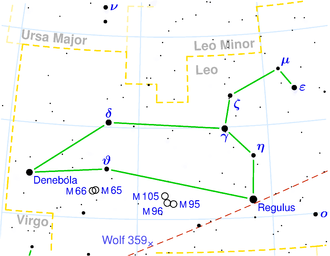NGC 3745
| Galaxie NGC 3745 | |
|---|---|
 | |
| Aufnahme der Galaxien NGC 3745, NGC 3746, NGC 3748, NGC 3750, NGC 3751, NGC 3753 und NGC 3754 mit dem Víctor M. Blanco Telescope. Diese Gruppe wird auch als Copelands Septet bezeichnet. NGC 3745 befindet sich mittig in dem leicht links abgebildeten Tripel. | |
| AladinLite | |
| Sternbild | Löwe |
| Position Äquinoktium: J2000.0, Epoche: J2000.0 | |
| Rektaszension | 11h 37m 44,4s[1] |
| Deklination | +22° 01′ 17″[1] |
| Erscheinungsbild | |
| Morphologischer Typ | SB(s)0-:[1] |
| Helligkeit (visuell) | 15,2 mag[2] |
| Helligkeit (B-Band) | 16,2 mag[2] |
| Winkelausdehnung | 0,4′ × 0,2′[2] |
| Positionswinkel | 102°[2] |
| Flächenhelligkeit | 12,5 mag/arcmin²[2] |
| Physikalische Daten | |
| Zugehörigkeit | Copeland's Septet[1] |
| Rotverschiebung | 0.031565 ±0.000077[1] |
| Radialgeschwindigkeit | 9463 ±23 km/s[1] |
| Hubbledistanz vrad / H0 | (421 ± 29) · 106 Lj (129,0 ± 9,0) Mpc [1] |
| Geschichte | |
| Entdeckung | Ralph Copeland |
| Entdeckungsdatum | 5. April 1874 |
| Katalogbezeichnungen | |
| NGC 3745 • PGC 36001 • MCG +04-28-004 • 2MASX J11374443+2201170 • Arp Teil von 320 • HCG 57G • VV 282 • | |
NGC 3745 ist eine linsenförmige Galaxie vom Hubble-Typ SB(s)0-: im Sternbild Löwe an der Ekliptik, die schätzungsweise 421 Mio. Lichtjahre von der Milchstraße entfernt ist.
Die Galaxie NCG 3745 bildet zusammen mit NGC 3746, NGC 3748, NGC 3750, NGC 3751, NGC 3753 und NGC 3754 die Galaxiengruppe Arp 320 und ergänzt durch die Galaxie PGC 36010 die Hickson Compact Group (HCG) 57. Halton Arp gliederte seinen Katalog ungewöhnlicher Galaxien nach rein morphologischen Kriterien in Gruppen. Diese Galaxiengruppe gehört zu der Klasse Gruppen von Galaxien.
Die Galaxie wurde am 5. April 1874 von dem britischen Astronomen Ralph Copeland entdeckt.[3]
Weblinks
Literatur
- Jeff Kanipe und Dennis Webb: The Arp Atlas of Peculiar Galaxies – A Chronicle and Observer´s Guide, Richmond 2006, ISBN 978-0-943396-76-7
Einzelnachweise
Auf dieser Seite verwendete Medien
Autor/Urheber: Copyright © 2003 Torsten Bronger., Lizenz: CC BY-SA 3.0
This is a celestial map of the constellation Leo, the Lion.
Autor/Urheber: DESI Legacy Imaging Surveys/LBNL/DOE & KPNO/CTIO/NOIRLab/NSF/AURA, Lizenz: CC BY 4.0
A group of galaxies nicknamed the Copeland Septet, in the constellation of Leo. Astronomers using images from Kitt Peak National Observatory and Cerro Tololo Inter-American Observatory have created the largest ever map of the sky, comprising over a billion galaxies. The final data release from the ambitious DESI Legacy Imaging Surveys sets the stage for a ground-breaking 5-year survey with the Dark Energy Spectroscopic Instrument (DESI), which aims to provide new insights into the nature of dark energy.



